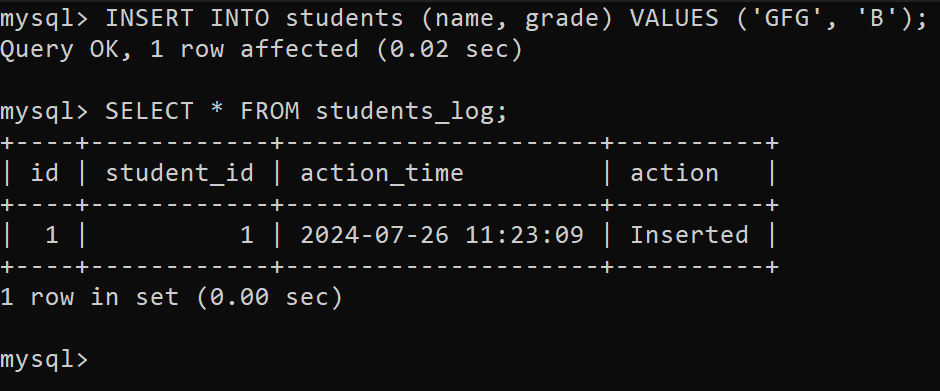
|
|
Database triggers are specialized procedures that automatically respond to certain events on a table or view. These events include actions such as INSERT, UPDATE, or DELETE. Triggers can be used to enforce complex business rules, maintain audit trails, or synchronize data across tables. In MySQL, triggers are useful concepts for automating and making sure of the integrity of database operations. MySQL Create TriggerThe CREATE TRIGGER statement in MySQL is used to create a new trigger in the database. It specifies the event (INSERT, UPDATE, or DELETE) and the timing (BEFORE or AFTER) of the trigger’s execution. When the specified event occurs, the trigger automatically executes the defined SQL statements, allowing for automated actions and data integrity enforcement. Syntax: The syntax for using Create Trigger in MySQL is as follows: CREATE TRIGGER trigger_name Parameters
MySQL Create Trigger ExampleLet’s look at some examples of the Create Trigger in MySQL. Learning the Create Trigger with examples will help in understanding the concept better. First, let’s create a table: Demo MySQL TablesWe create the table “students” in this example. CREATE TABLE students ( Output:  Output Example: Creating Trigger that Performs Logging Insert OperationsIn this example, we create a trigger named after_student_insert that activates after an INSERT operation on the students table. It inserts a record into the students_log table, logging the student_id and the action ‘Inserted‘ each time a new student is added. Step 1: Firstly we need to create a log table to track the insert operations. CREATE TABLE students_log ( Output:  Output Step 2: Now, we will create a trigger to log insert operation. DELIMITER // Step 3: Insert Data and Verify Log Insert a new record into the students table and then check the students_log table to see if the log entry was created: INSERT INTO students (name, grade) VALUES ('GFG', 'B'); Output:  Output ConclusionIn Conclusion, MySQL triggers are powerful tools that automate actions in response to specific events on database tables. By defining triggers with the CREATE TRIGGER statement, you can enforce business rules, maintain logs, and ensure data integrity automatically. Understanding and using triggers effectively can greatly enhance the functionality and reliability of your database operations. FAQs on MySQL Create TriggerWhat are the types of triggers available in MySQL?
Can a trigger call another trigger in MySQL?
Can a trigger modify the data being inserted or updated?
What happens if a trigger raises an error in MySQL?
|
Reffered: https://www.geeksforgeeks.org
| Databases |
| Related |
|---|
| |
| |
| |
| |
| |
Type: | Geek |
Category: | Coding |
Sub Category: | Tutorial |
Uploaded by: | Admin |
Views: | 22 |